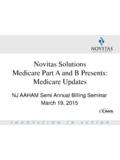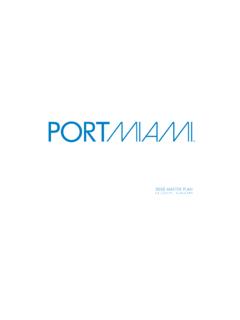Transcription of Healthcare Revenue Cycle 101 A B C - AAHAM Chapter
1 Healthcare Revenue Cycle 101. A B C. Friday, March 20, 2015. Dallas, TX. tx AAHAM 2015 Healthcare finance boot camp Objectives Introduce attendees to the basics of Healthcare finance Provide relevant information attendees can take back to their work environment Have interactive participation among attendees Share supporting materials for additional learning post class participation Enjoy The Day Have Fun! tx AAHAM 2015 Healthcare finance boot camp 2. Agenda 8:45 10:30 AM Healthcare Basics, including - Industry overview - The Healthcare delivery system - Affordable Care Act Revenue Cycle , including - Front End, Middle, Back End - Roles - Metrics - Contracting - Cash Collections 10:30 10:45 AM Break 10:45 12:00 Noon Revenue Cycle , continued 12:00 1:00 PM Lunch 1:15 3:30 PM Reimbursement, including - Medicare - Medicaid - Other payors - Government Cost Reporting - Hospital v OP v Physician Key Reimbursement concepts Healthcare Finance Basics, including - Concepts and Terminology - Key Financial Statements - Planning, Budgeting, Internal Controls A Glimpse into the Future tx AAHAM 2015 Healthcare finance boot camp 3.
2 Revenue Cycle 101. tx AAHAM 2015 Healthcare finance boot camp Healthcare Industry Information Composed of two main sectors: (Global Industry Classification Standard 2014). Health care equipment and services Pharmaceuticals & Biotechnology Many roles: Medical and Health Services Managers, Healthcare Practitioners and Technical Occupations, and Healthcare Support Occupations From September 2013 to September 2014 Healthcare has added an average of 20,000 jobs per month (Bureau of Labor Statistics October 3, 2014). tx AAHAM 2015 Healthcare finance boot camp 5. Healthcare What's Unique? Most customers don't choose to become a customer Hospitals and professionals seldom paid by the customer . Cost continue to rise faster than cost for other industries and general inflation Hospitals and Long-Term Care Facilities require 24x7.
3 Staffing Collections can be difficult since you can't repossess the service performed Credentials and certifications required for clinical staff tx AAHAM 2015 Healthcare finance boot camp 6. Healthcare Acronyms Imagine what it's like to be suddenly injured or ill. You or your family member calls 911. EMTs arrive and take you to the nearest ER or ED. You or someone in your family is given a lot of paperwork, including HIPAA notification. The doctors and nurses say you need an IV, MRI, and CT scan. And all this before you are admitted to the ICU.. Source: tx AAHAM 2015 Healthcare finance boot camp 7. Acronyms The Healthcare industry has its own language and it is usually understood only by those in Healthcare . Sometimes the same acronyms can have multiple meanings ( ADA has 26 meanings). Other common acronyms examples: IV, MRI = Medical conditions/procedures APHA, AAAHC, HFMA = Professional organizations FHFMA, CRCR = Certifications MD, NP, PA RN, LPN = Credentials HIPAA, ACA, CDC, CMS = Regulations AP, AP, GL = Financial functions Source: tx AAHAM 2015 Healthcare finance boot camp 8.
4 The Healthcare Delivery System Various Settings, including: Hospitals general acute care or specialty facilities Not-for-profit For profit Government Owned or Public Ambulatory or outpatient care facilities, including Home Care Long-term care facilities, including SNFs, ICFs, residential care facilities Diversification has led to Integrated Delivery Systems tx AAHAM 2015 Healthcare finance boot camp 9. The Regulated Business Side of Healthcare Heavily regulated by governmental and other standards Department of Health and Human Services ( ). HIPAA (Health Insurance Portability and Accountability Act). Protection of Human Research Subjects Health Information Technology Standards Additional Laws and Regulations tx AAHAM 2015 Healthcare finance boot camp 10. Regulations Civil and Privacy Rights Food & Drugs Fraud Prevention & Detection Freedom of Information Act & Privacy Act Certificate of Need (CON) state level Medical & Health Care Centers for Disease Control and Prevention ( ).
5 Medicare/Medicaid Centers for Medicare and Medicaid Services ( ). tx AAHAM 2015 Healthcare finance boot camp 11. Affordable Care Act Patient Protection and Affordable Care Act signed into law March 23, 2010. Individual Mandate Employer Requirements Expansion of Public Programs Premiums and cost-sharing subsidies to individuals Premium Subsidies to Employers Tax Changes related to health insurance or financing health reform Health Insurance Exchanges tx AAHAM 2015 Healthcare finance boot camp 12. The Uninsured 2013. Source: #. Most recent data available tx AAHAM 2015 Healthcare finance boot camp Health Insurance Coverage in the US. 2013. Uninsured, Medicaid/Other 13%. Public, 18%. Medicare, 15%. Employer- Sponsored Private Non- Insurance, Group, 6%. 48%. Total = $ million Source: Most recent data available Employers Already Scaling Back Coverage Erosion of Employer-Sponsored Coverage Well Underway Individuals Covered by ESI1 Contribution to Insurance Premiums Coverage for Family of Four Non-elderly Population Employer Worker fewer individuals 95%.
6 Growth 102%. growth 2002 2012 2002 2012. 25% 23%. Insured non-elderly adults Employers planning with deductibles $1,000 to offer CDHP2 as only or higher, 2012 plan option, 2014. Sources: Sonier J, et al., State-Level Trends in Employer-Sponsored Health Insurance, Robert Wood Johnson Foundation, April 2013, available at: 1. Employer-sponsored insurance. ; Collins R, et al., Insuring the Future, The Commonwealth Fund, April 2013, available at: ; Towers Watson, 2. Consumer-directed health plan. Reshaping Health Care, 2013, available at: ; Health Care Advisory Board interviews and analysis. tx AAHAM 2015 Healthcare finance boot camp 15. Characteristics of the Nonelderly Uninsured Population 2012. The federal poverty level was $23,050 or a family of four in 2012. Data may not total 100% due to rounding. SOURCE: KCMU/Urban Institute analysis of 2013 ASEC Supplement to the CPS.
7 Most recent data available tx AAHAM 2015 Healthcare finance boot camp Uninsured Rates Among the Nonelderly by State, 2012. Most recent data available tx AAHAM 2015 Healthcare finance boot camp 17. How does lack of insurance affect access to Healthcare ? Health providers can choose to not provide care to uninsured Only Emergency departments required by federal law to screen and stabilize Uninsured receive less preventive care and screenings Less likely to receive follow up care for chronic conditions leading to a decline in health In addition, uninsured twice as likely as those with health insurance coverage to have trouble paying medical bills tx AAHAM 2015 Healthcare finance boot camp 18. Question Will the Affordable Care Act make a difference? 19. Moody's Industry Outlook 2014. Moody's issued negative outlook for nonprofit hospital sector for the 6th straight year late November last year.
8 Major Factors Supporting Negative Outlook Lower Medicare payments Falling Disproportionate Share Hospital payments Patient volumes shifting to outpatient from inpatient Lower increases in Commercial payer rates Heavy health IT investments Changing reimbursement models Impact of Patient Protection and Affordable Care Act (PPACA). For-profit hospitals received positive outlook in February 2014 largely due to expected decrease in Bad Debt expense as more individuals become insured under ACA. Source: Source: 20. Revenue Cycle tx AAHAM 2015 Healthcare finance boot camp What is Revenue Cycle ? All the administrative and clinical functions, processes, and software applications that contribute and manage the registration, charging, billing, payment and collections tasks associated with a patient encounter. Revenue Cycle is the process that begins when a patient comes into the system and includes all those activities that have occurred in order to have a zero balance In other words, think Zero to Zero!
9 Tx AAHAM 2015 Healthcare finance boot camp 22. Understanding Revenue Cycle . Simple? The Revenue Cycle Front Front End End Middle Middle Back Back End End Patient Access In-House Activities Business Office Accounts Scheduling & Registration Receivable Management Ins. Verification &. Pricing Documentation Claims Cash Collection Charge Structure Coding Processing rd Charge Capture 3 Party Reimbursement PEOPLE, PEOPLE, PROCESS. PROCESS && TECHNOLOGY. TECHNOLOGY. Efficiency Effectiveness Accuracy Completeness Adaptability tx AAHAM 2015 Healthcare finance boot camp 24. Revenue Cycle 25%. 25% 55%. 55% 20%. 20%. FRONT. FRONT END. END MIDDLE. MIDDLE BACK. BACK END. END. Registration Denial Charge Capture HIM Clinical Coding & 3rd party Claims A/R. Patient Access Management & Pricing Documentation Reimbursement Processing Management Scheduling Case Charge Inpatient ICD-9 Coding Late Charge Recording: Management Structure Documentation Analysis - A/R.
10 Pre-registration HCPCS - Cash Charge Outpatient Coding EDI Editing and Insurance Denials and - Contractual Capture Documentation Billing Verification Appeals Phys Coding Bad debts Tracking Reconciliation Medical DNFB. Point-of-Service APC Process Reduction* Denial Management Records Collections Appeals Rate Setting Improvement assembly Self-Pay Process Call Center Managed Care process DRG Collections Technology Staffing Pricing / Assignment Management QA functions Deployment Contracting Registration Cost Agency DNFB. Points Late Charge Reporting Management reduction Analysis Prior Balance Observation Payer Adjudication Services Appeal/dispute 340b Rebates resolution Patient Access Redesign CDM Standardization Cash Acceleration PEOPLE, PEOPLE, PROCESS. PROCESS &. & TECHNOLOGY. TECHNOLOGY. Efficiency Effectiveness Accuracy Completeness Adaptability tx AAHAM 2015 Healthcare finance boot camp 25.







